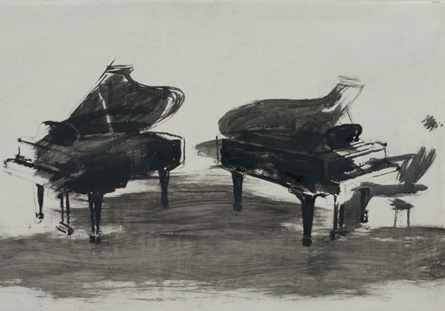Keyboard opposites eventually attract in duo program at Miami Piano Festival
“Debussy and Ravel through the Prism of Two Pianos” was the title given to the invigorating program offered by the Miami International Piano Festival Monday night at the Broward Center’s Amaturo Theatre in Fort Lauderdale.
The piano duo included the mesmerizing Italian, Francesco Libetta, and the extroverted Russian, Konstantin Lifschitz. Following up their individual recitals focusing on the music of Debussy and Ravel on Sunday, the two artists served up more French music concentrating on the rich diversity of sounds to be explored with two pianos
Claude Debussy’s En blanc et noir (“In White and Black”) presents a formidable challenge to pianists, causing the duo some difficulties in coordinating the simultaneous attacks. Given the need for phrases to develop over long periods, the performance as a whole was well paced and seemed to unfold naturally. Lifschitz vigorously encouraged the dramatic flow by stomping his foot on the stage at important points of arrival.
Still, the balance between the two performers tended to be uneven. In this Debussy piece, Lifschitz established his alpha musical personality right away. Libetta, on the other hand, seemed to have given up trying to compete in terms of volume, and took on more of an accompanimental role rather than that of an equal interpreter. The second movement’s military call, common to both pianos, was an especially obvious marker for the balance issue as it was passed between the performers. It sounded like perhaps Libetta was slightly underprepared for the deceptively challenging nature of coordinating a two-piano performance.
Ravel’s La Valse fared much better. Both pianists carried out the virtuosic figurations with carefree élan. As the waltz continued, becoming jarring and almost barbarous in intensity, Lifschitz again took the lead, steering the meandering dance through sudden, impulsive spasms. The duo fleshed out Ravel’s depiction of musical opulence with sweeping glissandos and intricate runs, adding incredible splendor to the sensuous theme. This thrilling performance, with its suspenseful conclusion, would normally have ended a concert. But, this was only the first half.
The final work, Olivier Messiaen’s ecstatic Visions de l’Amen (“Visions of the Amen”), took place after a well-received presentation by the author Stuart Isacoff, on the origins of impressionism. From beginning to end, the performers excelled at meeting the demands of negotiating Messiaen’s pervasive thematic extremes. Lifschitz’s opening material, sounding like the distant pealing of bells slowly coming into focus, was especially arresting due to the performer’s carefully nuanced voicings.
As a contrast, Libetta’s initial music evolved into a string of chords with a timeless quality. Libetta played them as if each chord were an isolated universe in itself. During this extremely challenging work, both pianists experimented with the differences and congruities of the wide-ranging musical language.
Later movements containing apocalyptic premonitions were played with indefatigable force, joyous dances between the players in the instruments’ extreme registers that seemed to distantly echo the repetitions of La Valse.
While Libetta’s performance initially lacked the dramatic flair and natural flow of Lifschitz, as the Messiaen progressed, the Italian pianist seemed to open up new dynamic territory, especially in the final movement where he produced a triple-forte version of the chordal sequence so important to the work. Lifschitz played with a concentrated melodic trajectory, always seeming to be aware of the musical line and how he could emphasize the dramatic qualities.
The final moments of the work were the complete opposite of the quiet sounds faintly heard in the distance at the beginning. Here, Lifschitz’s sonorous playing slowly transformed the dissonant chords of the beginning into consonances, playful and brilliant. Meanwhile, the unchanging harmonic sequence Libetta played became a scaffolding working in tandem with Lifschitz’s almost bebop-sounding runs.
Throughout the Messiaen, the two pianists’ sound worlds were clear and distinctive, the dichotomy effective in the sense that Messiaen’s composition is all about the contrasts of extremes.
After the Messiaen, a virtuosic encore would have been difficult to pull off. The duo instead offered Debussy’s Prelude to the Afternoon of a Faun, which served rather like a palette cleanser, the performers creating a luxurious wash of sound.
Richard Yates is currently pursuing his doctorate in composition at The University of Miami. He has performed as a tenor in San Francisco Bay Area choral ensembles and holds degrees from the University of Minnesota and Boston Conservatory in composition and conducting.
Posted in Performances
Leave a Comment
Tue Mar 5, 2013
at 1:07 pm
No Comments







